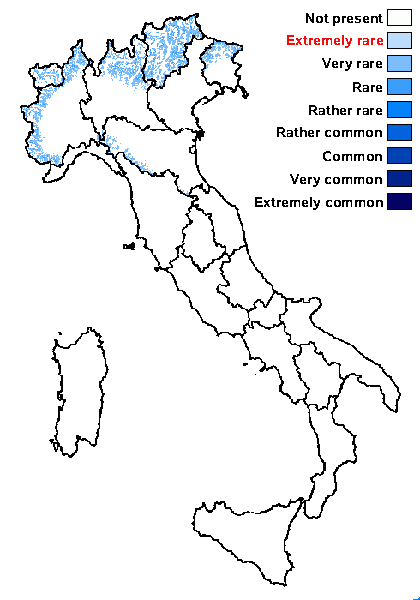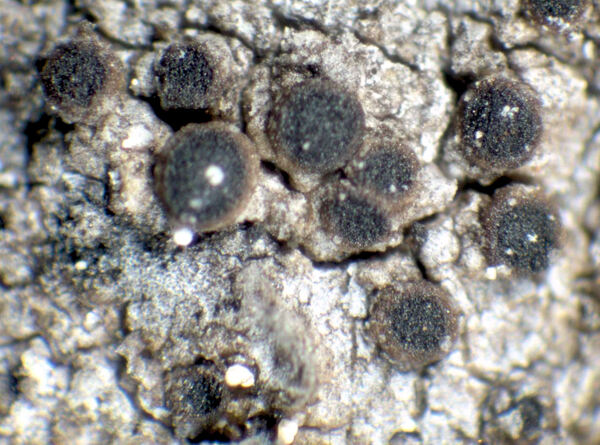Rinodina orculata Poelt & M. Steiner
Mitt. bot. Staatss. München, 8: 191, 1970.
Synonyms: Rinodina exigua f. corticicola Anzi; Rinodina trevisanii auct. p.p. non (Hepp) Körb.
Distribution: N - Frl (Giralt & Mayrhofer 1995), TAA (Mayrhofer & Sheard 2007, Nascimbene & al. 2007b, 2022), Lomb (Mayrhofer & Sheard 2007), Piem (Isocrono & al. 2004, Mayrhofer & Sheard 2007), VA (Piervittori & Isocrono 1999), Emil (Obermayer 2011, Fariselli & al. 2020).
Description: Thallus crustose, episubstratic, at first discontinuous and consisting of small warts, then continuously areolate, whitish, grey-brown or reddish-brown, matt, without a clear prothallus. Apothecia lecanorine, sparse, adnate to sessile, 0.2-0.4(-0.6) mm across, with a brown to brow-black, flat to slightly convex disc, and a thick, entire to flexuose, persistent thalline margin. Thalline exciple corticate, the cortex 5-10 μm thick, I+ faintly blue (reaction often difficult to observe); epithecium reddish brown, K-; hymenium colourless, 60-80 μm high; paraphyses branched in upper part, the apical cells swollen, 3.5-5.5 μm wide; hypothecium colourless, 50-80 μm high. Asci 8-spored, clavate, the K/I+ blue tholus penetrated by a faintly amyloid apical cushion with parallel or diverging flanks, the wall K/I-, surrounded by a K/I+ blue outer layer, Lecanora-type. Ascospores 1-septate, not constricted at septum, brown, ellipsoid, (10-)12-15(-17) x (6.5-)7.5−8(-9) μm, Physconia-type, with a well-developed, dark torus and a relatively prolonged Physcia-type stage, the wall smooth to minutely warted, with an ontogeny of type A (apical wall thickening after septum formation). Photobiont chlorococcoid. Spot tests: K-, C-, KC-, P-, UV-. Chemistry: without lichen substances.Note: on the bark of conifers and subalpine shrubs, especially common on Rhododendron; certainly more widespread in the Alps, mostly near treeline.
Growth form: Crustose
Substrata: bark
Photobiont: green algae other than Trentepohlia
Reproductive strategy: mainly sexual
Commonnes-rarity: (info)
Alpine belt: absent
Subalpine belt: rare
Oromediterranean belt: absent
Montane belt: very rare
Submediterranean belt: absent
Padanian area: absent
Humid submediterranean belt: absent
Humid mediterranean belt: absent
Dry mediterranean belt: absent

Predictive model
Herbarium samples


P.L. Nimis; Owner: Department of Life Sciences, University of Trieste
Herbarium: TSB (21835)
2001/11/29


Felix Schumm - CC BY-SA 4.0
[VZR188], Bohemia, merid., montes umava. Distr. Klatovy, in monte
Smrkový vrch, 1100 m. Ad corticem arboris (Acer pseudoplatanus).
Leg. A. Vezda et J. Liška, 21.6.1995, det. H. Mayrhofer. EX A. VEZDA:
LICHENES RARIORES EXSICCATI NR. 188.
Growth form: Crustose
Substrata: bark
Photobiont: green algae other than Trentepohlia
Reproductive strategy: mainly sexual
Commonnes-rarity: (info)
Alpine belt: absent
Subalpine belt: rare
Oromediterranean belt: absent
Montane belt: very rare
Submediterranean belt: absent
Padanian area: absent
Humid submediterranean belt: absent
Humid mediterranean belt: absent
Dry mediterranean belt: absent

Predictive model
| Herbarium samples |


P.L. Nimis; Owner: Department of Life Sciences, University of Trieste
Herbarium: TSB (21835)
2001/11/29


 INDEX FUNGORUM
INDEX FUNGORUM
 GBIF
GBIF
 DOLICHENS
DOLICHENS




